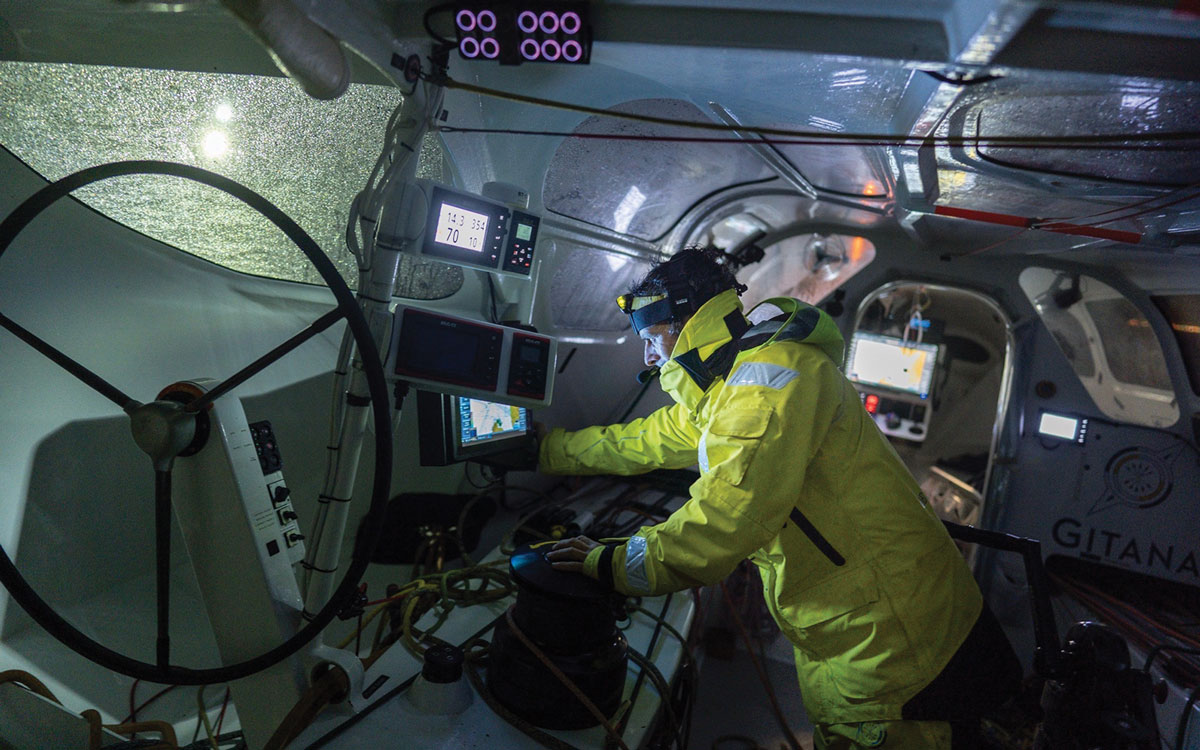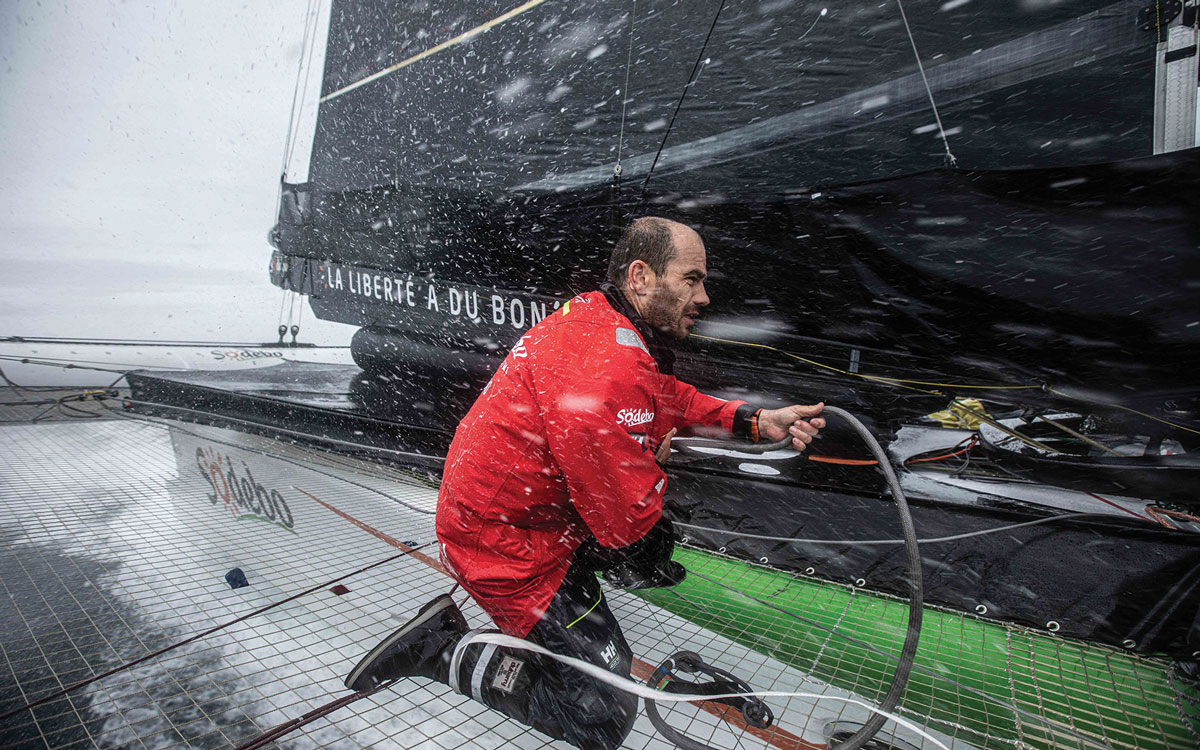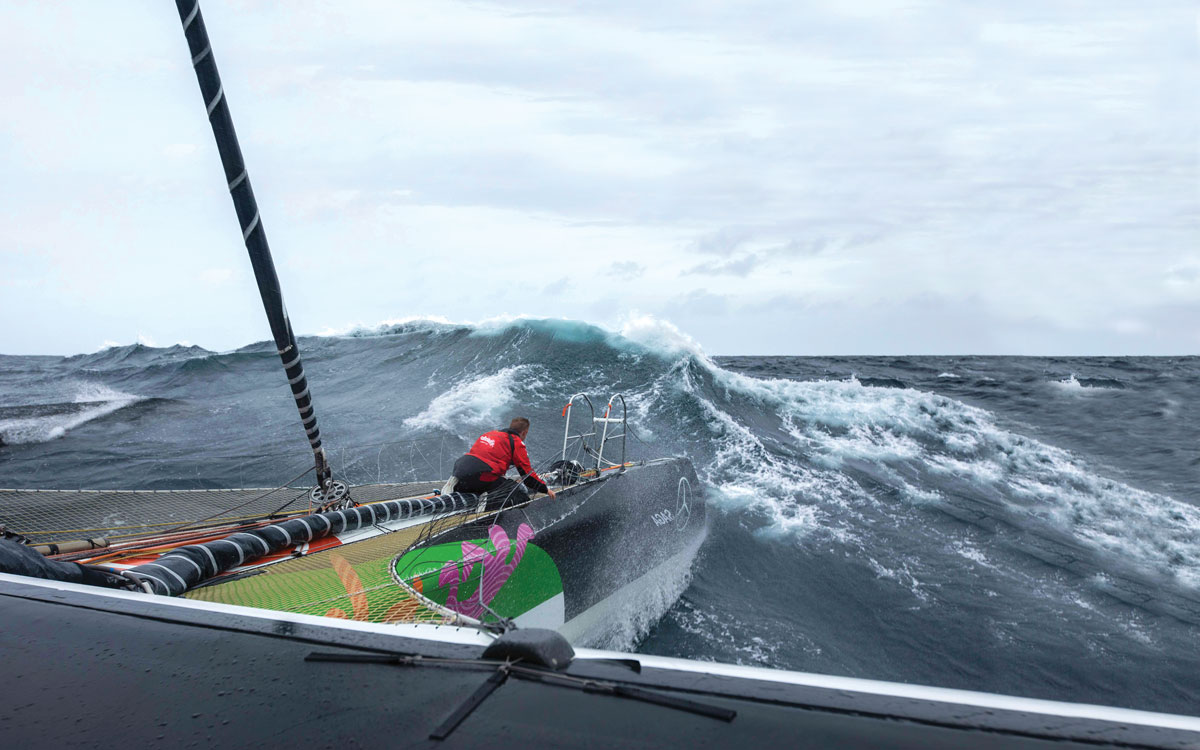Could the 40-day around the world record fall? Helen Fretter talks to this year’s Jules Verne challengers
Forty days, 23 hours, 30 minutes and 30 seconds: that is the time that is embedded in the psyche of crews currently challenging for the Jules Verne trophy.
The clock will mercilessly count down 983 hours as they attempt the near-impossible: to beat Francis Joyon’s blistering time set on Idec Sport three years ago; to become the first foiling trimarans to fly around the world; and maybe, just maybe, to break the incredible 40-day barrier.
The odds are stacked against them. Thomas Coville, skipper of Sodebo, says the chance of success is “only 20 to 25%”.
Charles Caudrelier, co-skipper of rival challenger Gitana 17, ranks his fortunes similarly. “I was surprised, I think the statistics are very optimistic, and in the statistics the boats never break, but it’s around a 30% chance to beat the record [based on] the polars. “Which is quite good,” he adds sanguinely.
On November 25, both trimarans set off within hours of each other on their first Jules Verne record attempt of 2020. Gitana had to turn back after three days after colliding with a ‘UFO’ (unidentified floating object), but the team has vowed to repair and restart as soon as possible.
Sodebo, meanwhile, was having a great run – extending to over 200 miles ahead of Idec Sport’s position, and regularly posting days with 30-35-knot averages. But on 11 December they too had to retire, after colliding with an underwater object and damaging the starboard rudder. Skipper Thomas Coville explained: “I am very disappointed, but I am not downcast because it is obvious: we will come back. We have a group and a boat to do it, we have a partner who wants to go back too, so the future is in front of us…. it got off to a good start, [and] it’s not over yet!”
But how do you plan to attack something with such a gossamer thin margin, when you have at best a 1 in 4 chance of success?
Man versus machine
There are two teams hoping to defy the improbable. Franck Cammas is looking to claim his second Jules Verne trophy with Gitana 17, the Edmond de Rothschild trimaran he co-skippers with Charles Caudrelier. Gitana will be sailing with a crew of just six.
The Verdier-designed Gitana was launched in 2017 and was originally part of the embryonic Ultime class, but the team wanted to incorporate more automation than Ultime rules permitted and this year stepped out of the class. For the Jules Verne, they have a flight control ‘servo loop’ that automatically trims some of the foils.
Article continues below…
Battle of the giants: The inside story of the Brest Atlantiques Race
On Tuesday 5 November four giant trimarans – Maxi Edmond de Rothschild, Macif, Sodebo and Actual Leader, and their double-handed…
Trying to break the 40-day barrier: Thomas Coville and the most radical Ultime yet
This week solo yachtsman Thomas Coville opened the doors to the build of his Sodebo Ultim 3, the newest Ultime…
“It’s not a race, so we are allowed to use an auto-trim for the appendages,” explained Caudrelier. “We don’t have enough energy to [use it] to move the foils, but all the flaps of the rudders and the daggerboards can be managed by the pilot. It’s new, and it’s quite efficient.
“The question is: how much energy do we want to spend on that, [how much] weight of fuel do we carry? So we have to find a balance, but we think we’ll use it probably 50% of the time, because in certain conditions it’s really another jump of performance.” The gain can be as much as 5%.
The Gitana team will be sailing with two crew on deck on watch, and a third on standby. “With two guys we can have one driver and one adjusting all the appendages. On these big boats you don’t trim the sails so much, you find an average and you don’t spend your time trimming because you would kill your rigging very quickly,” says Caudrelier.
Thomas Coville has taken a different approach, choosing to sail with eight. His Sodebo Ultim 3 is the newest of the big tris, and designed to be lighter, less loaded, with a smaller sailplan. It is not automated.
“I decided to invest in humans,” Coville says. “I’ve made the choice to be eight to have two guys – myself and Mark Keruzoré, our media man – off watch. Then two guys on stand-by and two guys off, and you can be sure that when you’re off, you won’t be disturbed.”
Rest will be key. “These machines need to have people who are well recovered, that are fresh and can concentrate. We’re going to be potentially able to steer all the time. We’ve got autopilot, but sometimes you need to be to be 100% and to push the boat,” he explains.
Autopilot development in both the foiling multihulls and IMOCAs has made huge advances, but there are still conditions when a human on the wheel is faster, particularly in downwind VMG mode.
Constant crew rotation will be necessary, however, because maintaining concentration on the helm is so critical. “One hour is the maximum. When we are flying in VMG mode it’s a very narrow margin on the helm and you have to be very concentrated,” explains Cammas.
There are other drains on the crew. Besides the workload of manoeuvres, simply existing on board is exhausting. “These boats are pretty hard on your body now,” explains Sodebo crew member Sam Goodchild, “We do everything we can to avoid injuries, which includes protective gear. We’ve got helmets and skullcaps and padding in basically everywhere you can have padding in foul weather gear.”
The relentless noise of flying through the ocean for five weeks is also energy sapping. “Life on board is quite difficult. With the foils humming and just the banging of waves going fast all the time it’s quite tiring. So we take earplugs and noise cancelling headphones to help us with our off watches,” explains Goodchild.
The noise level is so high that a crew member in the pit, basically next to the helmsman’s knees on Sodebo, would not be able to hear the helmsman in his ‘tank commander’ driving position, so they use a headset comms system.
“In every manoeuvre we’ve got the helmsman, pitman and bowman connected and there’s also a speaker in the cockpit so the whole cockpit can hear what’s happening,” explains Goodchild. “The apparent wind over the deck is huge; if the boat’s going 30, 40 knots, which is quite normal, and we’ve got 25 knots of wind you can have 50 or 60 knots of apparent wind over the deck quite easily. So fairly quickly you don’t hear a lot!”
20,000 miles of foiling
The trimarans are on the very edge of development and go through a constant cycle of modifications. Since last year’s Brest Atlantiques race the Gitana team has worked on aerodynamics, including a new cuddy roof which endplates more closely to the boom, and altering the angles of the enormous fairings that stretch across the beams.
The foil and appendages shapes have also been refined. “Today our big problem is cavitation, because we reach some very high speeds, 45 or 46 knots,” says Caudrelier. The jumps in performance are considerable. “We have managed to push the maximum speed before cavitation from around 40-42 knots to 44-45 knots, so that’s a big step. The boat has never been so fast.”
Sodebo has also gained T-foils on the centre daggerboard and main rudder, which means that sustained flight is now possible at levels that are surpassing even Coville’s expectations. “Last week we were delivering the boat for sponsor sailing in Vendée. For three hours, we were in rough seas. It was 4 or 5m on the offside and we were sailing between 35-45 knots of boat speed all the time. I have to admit that I would not have even imagined that one year ago.”
Over the 26,000-odd miles of their circumnavigation, how much could potentially be sailed in foiling mode? “About a year ago, I would have told you 20%. Now, I would say it could be more like 80%,” says Coville, “And we are just at the beginning. Every day we go sailing, we’re learning more. But I’m pretty sure that we are going to fly for more than 50%.”
Caudrelier agrees: “If you stop flying you lose more than 10 or 20% of performance, so it’s not the same boat. And there will be strong winds where we will not really fly, but we will be in skimming mode, when the waves are too big. But still, 50 to 60% around the world in some sort of flight mode is space travel.”
Shoreside commanders
Yet a Jules Verne record is not won on the water: a huge factor in each challenger’s chances is down to their weather routing, directed by a commander on shore.
Sodebo’s weather router is Jean Luc Nelias, Coville’s right hand man for many years, who also directed him to his 2016 solo around the world record. Gitana has the legendary Marcel van Triest, who has worked with Caudrelier and Cammas closely in the past on their Dongfeng and Groupama campaigns, and routed both Loïck Peyron on Banque Populaire and current record holder Francis Joyon on Idec Sport to Jules Verne wins.
The first, and greatest, challenge is to choose the best weather window in which to leave Ushant. Get this wrong – even by a few hours – and a team’s chances of beating the record could be over even before they have exited the Bay of Biscay.
With the benchmark time to the Cape of Good Hope less than 12 days, there is a balancing act between not only finding the optimal forecast for the Atlantic, but also setting up the boat with the best chances of hooking into a favourable low pressure system roaring eastwards around the Southern Oceans.

‘These new machines are going to beat the record. It will happen’ – Thomas Coville. Photo: Martin Keruzoré
“I try to look at the situation from the start line in Ushant to more or less the point of entry to the Indian Ocean, so basically south of Cape Town,” explains van Triest. “We know the reference times for that, so we can have a forecast, although in the South Altantic it will be no more than a trend.
“Then you try to judge what happens after Cape Town, because you can have a situation with a high pressure ridge off South Africa and ice to the south, which makes the entry into the Indian Ocean really narrow. To get around it, if you see a situation that is a 600-mile wide entry into the Indian Ocean, you’re willing to arrive at Cape Town a little bit slower, but it will be easier to get into the westerlies.
“Also, these boats are now so quick that you need a Southern Ocean weather system that is quick enough that they can stay in the same system the whole time. So you’re going around at more or less at the speed that the low is.” Idec Sport, van Triest says, rode a single system from Madagascar almost to New Zealand.
The Atlantic may also be where the foilers make the biggest gains on the record. “Where we have most improved the speed of the boat is upwind reaching – like the parts of the Doldrums where you are upwind and slowly the wind is lifting. This is where we have the biggest difference of speed compared to boats like Idec,” says Caudrelier.
“Their upwind speed was between 19-21, now we can achieve between 25-30 depending on the sea state.” In order to determine the best window, van Triest is reanalysing historic weather data. “We have done 6,000 routings covering the last 12 years,” explains Caudrelier, “One start every six hours, every day, during the standby period.”
Seeing the unknown
Once the crews are underway, the routers will fall into a twilight world of 24-7 weather analysis, endlessly programming routes further and further down the track and offering a constant stream of information to the skippers. One key decision is how far south to go, and for that the routers need to know where the icebergs are. Sailing additional mileage to avoid ice can be fatal to a record bid’s chances; not avoiding ice at 35 knots doesn’t bear thinking about.
“They’re going to a part of the world no one is interested in. Further north there is commercial shipping, and further south is the ice shelf where there is lots of scientific interest, but the bit in the middle: no-one cares basically. Which means there is very, very little data available in the public domain,” explains van Triest.
The solution is to request the data from specialist companies. “We use a company called CLS. They’ve got two techniques mainly: one is with altimeters that measures the distance from satellites to the Earth’s surface, or sea level in this case, and if that is higher because there is an object there, you know it is either an iceberg or a ship.
“Then you cross-reference that against AIS to take out any ships, and the other ones are possibly ice. The disadvantage is this has got a very narrow footprint, so it’s like throwing a big fishing net to catch a small fish.

Gitana’s crew have been maximising sea trial time in preparation for the gruelling Jules Verne Trophy attempt. Photo: Eloi Stichelbaut / PolaRYSE / Gitana
“That defines the zones that are really of interest. And then you can order pictures, which are called SAR images. They are done with a radar on a satellite: the scatter that comes back from the earth’s surface gets captured, and analysed and it creates an artificial image.” But the costs of this are eye-watering: a single image can easily range up to £4,000. “It adds up pretty quickly,” notes van Triest.
Request your image at short notice and the price rises steeply, request it too early, and the ice may have drifted from its known position, rendering it useless. That the Jules Verne trimarans are likely to be in the Southern Ocean at a similar time to this year’s Vendée Globe fleet may ameliorate the costs slightly, as the Vendée race committee will also be analysing ice position.
It is not only ice that the crews need to avoid. During the Brest Atlantiques Race three-quarters of the Ultimes suffered serious foil damage, all attributed to suspected collisions with unidentified floating objects. The teams are trying to develop various solutions, but none are reliable.

Gitana 17 training off Lorient – the new trimarans have made major upwind speed gains. Photo: Eloi Stichelbaut / PolaRYSE / Gitana
They include a ‘whale pinger’ – an alarm audible to sea life that is designed to scare large mammals away from the oncoming boat – and an infrared camera in the mast that interfaces with software to identify hazards. At these speeds, however, its accuracy is limited.
“It is supposed to send an alarm when it sees something not normal in the water, but that is very difficult and it’s not working well. We are working every day on it but it’s just the beginning of this system,” explains Caudrelier.
Sodebo employs similar systems, but Coville concedes that, in practical terms, “We’ve got nothing, or nothing real.” Rather than trying to avoid collisions, they have been trying to protect the boat against the inevitable, with hydraulics that can absorb some of the loads if the rudders or boards have a moderate impact.
“You can’t avoid everything, but [the hydraulics] can absorb 10 or 15 tons sometimes. They’ve been working pretty good actually, and a few times it’s saved our boat already,” he explains. “We want to control more and more, but at some stage you have to accept that you can’t control everything.”
Breaking 40
So are this generation of foiling adventurers attempting the impossible? Marcel van Triest knows the true chances of setting an around the world record better than almost anybody, based on cold, hard data: “I think sub-40 days is very realistic, given the potential of the boats.
“To get under 39, you need a perfect window. You need a bit of a break with the ice, and you need a bit of luck in the Atlantic coming back up. And above all, you have to keep all your bits underwater attached to the boat.”
The ebullient Thomas Coville is not a man who worries about things being deemed impossible. “I don’t know if we’re going to beat that record this year, it’s the first time that a flying boat is attempting it. But one thing I know is that it is going to be beaten. There’s no doubt in my mind that these new machines are going to beat that record. It will happen.”
First published in the December 2020 issue of Yachting World.














